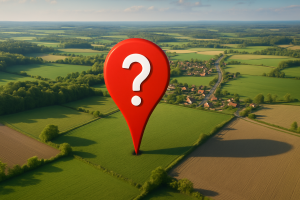Location intelligence is becoming increasingly central to enterprise analytics, with organizations in sectors such as retail, logistics, and financial services integrating geospatial data into decision-making systems. A 2016 McKinsey report projected that data-driven decision-making could generate trillions in economic value, with location data playing a key role in operational and strategic improvements (Manyika et al., 2016). Yet too often, location intelligence stops at the “where” , relying on maps, heatmaps, and dashboards that answer where events occur but fail to uncover why they happen. In a world where spatial data is richer and more interconnected than ever, it’s time to reframe the question.
Beyond Map-Centric Thinking
In a previous post, we explored how geospatial thinking often extends beyond visual maps and into the structure of the data itself. This post builds on that perspective by examining how organizations can move from observing where things happen to understanding why they happen.
Traditional geospatial tools have served us well by constructing maps from layers of information , showing us densities, boundaries, and movements. But these layers often describe what is happening, not what is causing it. They prioritize representation over interpretation.
As geographer Rob Kitchin observed, data infrastructures are shaped by what they are designed to reveal , and too often, spatial tools are built around display rather than reasoning (Kitchin, 2014). A map may show that customer churn is higher in certain neighborhoods, but it won’t explain the underlying factors , such as infrastructure decay, service gaps, or shifting demographics. The real opportunity lies not in seeing where something happens, but in understanding why it happens there , and what to do about it.
Why ‘Why’ Matters
In this context, understanding why means uncovering the underlying factors, influences, and sequences that drive spatial events. This goes beyond simply observing patterns to reveal the relationships and conditions that cause them. At its core, this means identifying causal factors (what directly or indirectly triggers an event), recognizing spatial influence (how neighboring locations or connected networks impact outcomes), and analyzing temporal sequences (how events unfold over time and shape one another).
To uncover the why, organizations must expand beyond latitude and longitude. They must analyze relationships, influences, and sequences that affect outcomes. This means incorporating spatial-temporal data, behavioral context, and causal modeling into their workflows.
For example:
- Why do outages cluster in specific parts of a grid?
- Why do certain stores underperform despite high foot traffic?
- Why does a transportation route fail under specific weather conditions?
These questions require a shift from descriptive to diagnostic and predictive reasoning. As Harvey Miller emphasized in his work on time geography, it’s essential to understand how entities move through space over time , and how those movements interact (Miller, 2005).
Enabling the Shift from Where to Why
Several techniques support this evolution:
- Spatial-temporal modeling captures how patterns change over time and space, useful for everything from crime forecasting to disease tracking.
- Graph-based spatial reasoning allows entities to be analyzed in networks of relationships , for example, how upstream supply chain disruptions propagate downstream.
- Machine learning models can incorporate spatial lag and neighborhood context as predictive features, treating geography as more than metadata.
Spatial-temporal modeling has proven essential in forecasting dynamic phenomena such as urban crime, traffic congestion, and disease spread. For instance, spatial-temporal models were central to COVID-19 response strategies, enabling public health officials to predict transmission hotspots and allocate resources accordingly (Yang et al., 2020).
Graph-based spatial reasoning enhances the ability to model systems as interconnected networks rather than isolated locations. This is especially useful in domains like disaster response and logistics. Recent research by Attah et al. (2024) explores how AI-driven graph analytics can improve supply chain resilience by revealing hidden interdependencies and points of failure across logistics networks.
Machine learning techniques are increasingly integrating spatial features to improve prediction accuracy. By incorporating spatial lag , the influence of neighboring observations , models can more accurately predict property values, infrastructure failure, or customer churn. The PySAL library, for example, supports spatial regression and clustering techniques that extend traditional ML approaches to account for spatial dependence (Rey & Anselin, 2010).
A wide range of modern technologies now support advanced spatial reasoning and spatio-temporal analytics at scale. These include open-source databases like PostgreSQL with PostGIS for spatial querying, graph databases such as Neo4j for topological reasoning, and analytical libraries like PySAL for spatial econometrics and clustering. Complementing these are cloud-native tools and formats that enhance scalability, flexibility, and real-time responsiveness. Columnar storage formats like Parquet and Zarr, distributed processing frameworks such as Apache Spark and Delta Lake, and streaming platforms like Kafka all enable organizations to model space and time as interconnected dimensions , moving beyond static maps toward continuous, context-aware decision-making.
Such methods shift the focus from identifying where something happened to uncovering why it happened by revealing the spatial dependencies, temporal sequences, and system-level interactions that drive outcomes. Far from being merely theoretical, these techniques are already delivering measurable impact across a wide range of sectors including public health, logistics, urban planning, and infrastructure. Organizations that embrace them are better positioned to make timely, data-driven decisions grounded in a deeper understanding of cause and context.
How Cercana Helps
At Cercana Systems, we help clients build deep-stack geospatial solutions that go beyond visualization. Our expertise lies in:
- Designing data architectures that integrate spatial, temporal, and behavioral signals
- Embedding spatial relationships into data pipelines
- Supporting location-aware decision-making across logistics, infrastructure, and public services
We help clients uncover the deeper patterns and relationships within their data that inform not just what is happening, but why it’s happening and what actions to take in response.
Conclusion
The future of location intelligence lies not in better maps, but in better questions. As spatial data grows in scope and complexity, organizations must look beyond cartography and embrace spatial reasoning. Reframing the question from “Where is this happening?” to “Why is this happening here?” opens the door to more strategic, informed, and adaptive decision-making.
References
Attah, R. U., Garba, B. M. P., Gil-Ozoudeh, I., & Iwuanyanwu, O. (2024). Enhancing supply chain resilience through artificial intelligence: Analyzing problem-solving approaches in logistics management. International Journal of Management & Entrepreneurship Research, 6(12), 3883–3901. https://doi.org/10.51594/ijmer.v6i12.1745
Kitchin, R. (2014). The data revolution: Big data, open data, data infrastructures and their consequences. SAGE Publications. https://doi.org/10.4135/9781473909472
Manyika, J., Chui, M., Brown, B., et al. (2016). The age of analytics: Competing in a data-driven world. McKinsey Global Institute. https://www.mckinsey.com/capabilities/quantumblack/our-insights/the-age-of-analytics-competing-in-a-data-driven-world
Miller, H. J. (Harvey J.) (2005). A measurement theory for time geography. Geographical Analysis, 37(1), 17–45. https://doi.org/10.1111/j.1538-4632.2005.00575.x
Rey, S. J., & Anselin, L. (2010). PySAL: A Python library of spatial analytical methods. In Handbook of Applied Spatial Analysis (pp. 175–193). Springer. https://doi.org/10.1007/978-3-642-03647-7_11
Shekhar, S., Evans, M. R., Gunturi, V. M., Yang, K., & Abdelzaher, T. (2014). Spatial big-data challenges intersecting mobility and cloud computing. 2012 NSF Workshop on Social Networks and Mobility in the Cloud. http://dx.doi.org/10.1145/2258056.2258058Yang, W., Zhang, D., Peng, L., Zhuge, C., & Hong, L. (2020). Rational evaluation of various epidemic models based on the COVID-19 data of China. Mathematical Biosciences and Engineering, 17(3), 3051–3064. https://doi.org/10.1016/j.epidem.2021.100501


